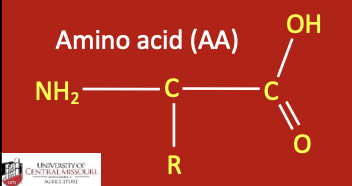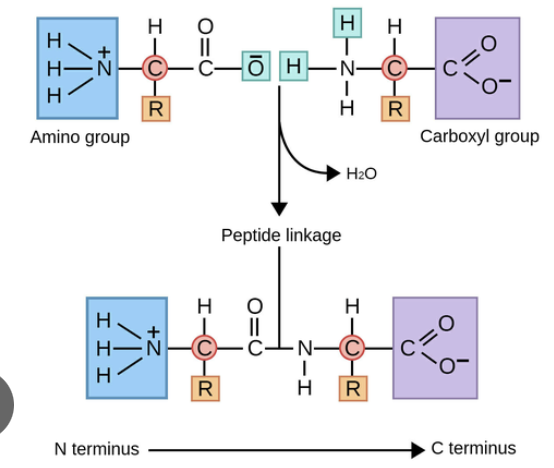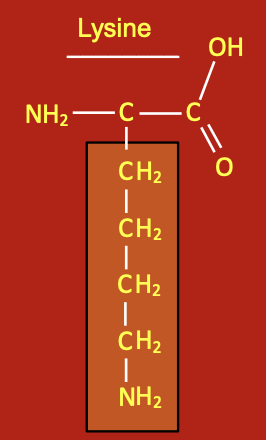UCM Animal Nutrition Exam 1
1/124
There's no tags or description
Looks like no tags are added yet.
Name | Mastery | Learn | Test | Matching | Spaced |
|---|
No study sessions yet.
125 Terms
diet
a specific mixture of feedstuffs used to supply nutrients to an animal
ration
The daily allocation of the diet that has been formulated for the animal
Monogastric
an animal with a monogastric GI tract has a stomach with one compartment
ex) swine, poultry, horses (enlarged cecum = hindgut fermenter), dogs, cats
ruminant
an animal with a ruminant GI track, has a stomach with four compartments
ex) cattle, sheep, goats
plant products consumed by animals
seeds (grain)
high energy density due to highly digestible carbs and lipids
leaves and stems
low energy density due to lowly digestible carbs and lack of lipids
farm animal diets are formulated primarily on the amount of ….
energy and protein required by the animal
digestion
the process by which feedstuffs are broken down into microscopic nutrient molecules
digestion via mechanical action
breakdown of feedstuffs by mastication and gastrointestinal muscular contractions
digestion via chemical action
breakdown of feedstuffs by acids in the gastrointestinal tract
digestion via enzymatic action
breakdown of feedstuff by enzymes in the gastrointestinal tract
absorption
process by which nutrients are absorbed from the GI tract through villi along the wall of the small intestines and into the bloodstream of the body
three classes of nutrients that provide energy to the animal
carbohydrates
lipids
proteins
three nutrient classes that do not provide energy to the animal
water
vitamins
minerals
enzymes
special proteins that catalyze reactions in the body
growth and production
condition is which animal is producing muscle tissue, milk, eggs, offspring to power
maintenance
condition in which the animal is maintaining, neither gaining or losing body condition
why is the animal’s stage of production so important?
young animal require high levels of energy and protein in the diet to grow
mature animals require low levels of energy and protein in the diet because they are no longer growing
what is the overall goal of an animal nutrition feeding program?
to feed a balanced diet in a ration containing feedstuffs that meet the daily nutrient requirements of the animal, which is based on the stage of production for that animal
hindgut fermenter VS monogastrics
hindgut fermenter has an enlarged cecum (horse)
why can ruminants and hindgut fermenters thrive on forages whereas monogastrics can not?
forages can only be digested by microbes, hangout fermenters and ruminants have microbial digestion
cellulase
enzyme produced by microbes to break down forages
where does microbial digestion occur in ruminants?
rumen and cecum
where does microbial digestion occur in hindgut fermenters?
cecum
order the GI tracts from most forage consumed and digested to least
ruminants - 44%
hindgut fermenter - 39%
monogastics = 22%
prehension of monogastics
bring food to the mouth, tongue is used
mastication of the monogastrics
means to chew, top and bottom incisors and molars
feed bolus
a soft mass of masticated feed, saliva produced in the salivary glands moistens and lubricates the feed, swallowing this is called deglution
what type of digestion occurs in the mouth?
mechanical and enzymatic digestion
amylase
enzyme present in the saliva to begin starch digestion
peristalsis
the contraction of the smooth muscles in the esophagus to move the feed bolus
sphincter
muscular structure that constricts to restrict the movement of body fluids in the body
ex) the sphincter at the entrance to the stomach keeps hydrochloric acid from refluxing into the esophagus but relaxes to allow the feed bolus to enter the stomach
what kind of digestion occurs in the stomach?
chemical : hydrochloric acid
enzymatic : pepsin
mechanical : muscular contraction
NOT the major site of digestion and NO absorption occurs
pepsin
enzyme secreted into the stomach to digest protein
what keeps the stomach from digesting itself?
to avoid being digested by hydrochloric acid and pepsin, mucous is produced by special cells lining the inside of the stomach coating the stomach in protection
chyme
partially-digested feed
food bolus → chyme (after it passes out of the stomach)
order the three sections of the small intestine of monogastrics
duodenum, beginning section, connects to the stomach, MAJOR SITE OF DIGESTION
jejunum, middle section
ileum, end section, connects to the large intestine
what makes the duodenum the major site of digestion in monogastrics?
because the duodenum receives secretions from the gall bladder of the liver and the pancreas
job of gall bladder secretions
bile is stored in the gall bladder from the liver
this bile is then secreted when chyme is released from the stomach to help digest fat
the process of bile preparing the lipids for digestion is a process called emulsification
* this is all happening in the duodenum of the small intestine *
job of pancreas secretions
secretes buffers to increase the pH of the chyme to avoid damage to the epithelial cells that line the duodenum
pH is originally low after coming out of the hydrochloric acid from the stomach
secretes enzymes to aid in digestion
protease = proteins
amylase = starch
lipase = lipids
* this is all happening in the duodenum of the small intestine *
what causes the secretion of buffers and enzymes from the pancreas?
two hormones are released in response to nutrients in the chyme and the low pH
secretin = causes release of buffers fro pancreas to raise the pH
cholecystokinin = causes release of enzymes and bile
job of the jejunum and ileum
MAJOR SITES OF ABSORPTION because of the villi that line the inside and increase the surface area of the small intestine
what happens if the villi of the jejunum and ileum regions of the small intestine are destroyed?
diarrhea !
absence of villi means the nutrients in the chyme are not being absorbed and instead the chyme passes straight through the small intestine
where is the cecum loacted in monogastrics?
between the small intestine and the large intestine
not a major site of microbial digestion in monogastric (swine, poultry)
instead some microbial digestion occurs in the colon
job of the large intestine in monogastrics
water absorption
job of the rectum
temporary storage of feces
four compartments of the ruminant stomach
rumen
reticulum
“reticulorumen”
omasum
abomasum
ruminant teeth
bottom incisors with hard “dental pad” on top
molars on top and bottom
bicarbonate
chemical buffer produced in saliva that helps maintain the correct pH in the rumen
microbes needs a pH of 6-6.5 for microbial digestion
job of the esophagus in ruminants
transport the feed bolus from the mouth to the retculorumen
what is rumination?
the process that ruminants use to get more nutrients from the food
microbial digestion
especially important to digest forages
reticulorumen
consists of both the reticulum and rumen
rumen is lined with finger-like projections called papillae
reticulum is lined with ridges that form honeycomb pattern
rumen
primary location of microbes and site of microbial digestion
largest compartments of the stomach
mature bovine can hold 40-50 gallons of fluid
why is microbial digestion so effective in the rumen?
the rumen is the site of a mutualistic symbiotic relationship (both organisms benefit)
forages are consumed but cellulose can not digest → microbes in the rumen consume the cellulose (this benefits the microbes) and produce volatile fatty acids → the volatile fatty acids are absorbed and used as energy, microbes can be digested and used as a protein source (this benefits the ruminant)
why do microbes like the rumen?
because it is warm, moist, and low in oxygen which allows anaerobic microbial digestion to occur (anaerobic = little or no oxygen)
what three volatile fatty acids are produced during microbial digestion?
acetate
propionate
butyrate
how does the ruminant animal get protein is the microbes consume protein to create volatile fatty acids?
after some time in the rumen, the microbes make their way through the digestive system with the digest and are killed in the abomasum.
they are then digested in the duodenum and the amino acids from the digested protein from the microbes is absorbed in the jejunum and the ileum to provide the protein for the ruminant.
how/where are the volatile fatty acids absorbed?
through the papillae in the rumen wall
reticulum job
main function: regurgitate partially digested feed back to the mouth for rumination
also helps to catch foreign objects in feed to protect the digestive tract
omasum job
not understood completely, mainly responsible for moving digesta into the abomasum, absorbing excess fluid from the rumen, absorbing VFAs and grinding of the digest from the rumen
abomasum job
TRUE STOMACH OF THE RUMINANT (all three types of digestion occur; mechanical, chemical, and enzymatic)
mixes the feed bolus with hydrochloric acid (chemical) and pepsin (enzymatic) by muscular contractions (mechanical)
compare and contrast the ruminant small intestine to the monogastric small intestine
comparisons:
the pancreas and the gall bladder secrete enzymes, buffers, and bile into the duodenum
protein and lipid digestion and absorption occurs
contrasts:
is not the major site of carbohydrate digestion and absorption because the majority of carbohydrates have already been digested and absorbed as VFAs in the rumen
cecum job in ruminants
second opportunity for microbial digestion of forage, nothing compared to the microbial digestion happening in the rumen
VFAs produced here are absorbed through the cecum wall
newborn ruminant rumen
nonfunctional and nonexistent
milk flows from the mouth → esophagus → omasum → abomasum
reticular groove
important in young ruminants
prevents milk from flowing into the undeveloped rumen
forms in response to the sucking reflex
development of the rumen
rumen will begin developing over a six week period after birth
development is dependent on the consumption of solid food
as forage is consumed this allows for microbial digestion to occur which produced VFAs and causes the development of papillae
when is the rumen developed enough for weening?
1-5 month of age the rumen is developed enough to survive on forages
sheep/goats = 1 month
cattle = 3.5-5 months
rumen size percentage change during development
reticulorumen = 30% of the stomach
abomasum = 60% of the stomach
reticulorumen = 85% of the stomach
abomasum = 8% of the stomach
distribution of feedstuffs in the rumen
forages are on top of the rumen fluid (raft)
grains sinks to bottom of the rumen fluid
define hindgut fermentation
microbial digestion takes place in the cecum located between the small intestine after the feed has passed through the stomach
why are the microbes not a source of protein in hindgut fermentation?
since microbial digestion takes places after the stomach it is impossible for the microbes the be killed in the stomach (by protease related from the pancreas) and digested as proteins and absorbed in the small intestine
horse teeth
top and bottom incisors and molars
esophagus in hindgut fermenters
feed only travels down the esophagus
hindgut fermenters CANNOT vomit
this is an issue if something poisonous is eaten because the horse cannot throw up to alleviate the problem
hindgut fermenter stomach
main site of digestion bc all three forms of digestion occur (mechanical, chemical, and enzymatic)
hydrochloric acids kills most microbes but some survive and live in the cecum to perform microbial digestion
hindgut fermenter small intestine
normal three sections and functions
horses do not have a gallbladder
liver continuously releases bile instead
no gall bladder because horses do no consume a high lipid diet so the bile does not need to be stored to emulsify the lipids
hindgut fermenter cecum
SITE OF MICROBIAL DIGESTION
chyme flows in the cecum → digested by microbes → flows out the cecum the way it came in
no enzymes to buffered are secreted
VFAs are produced from microbial digestion
absorbed in the cecum and colon (large intestine)
main source of energy for the horse
horse cecum = 4ft long and hold 8 gallons
swine cecum is only 10in long and holds 0.5 gallons
colic
pained caused by the sharp turn of the horses’ large intestine which lead to compaction of feces and blockages, can lead to death if not treated
compare and contrast the microbial digestion of the hindgut fermenters and ruminants
compare:
both used forages for energy by microbial digestion
contrasts:
hindgut fermenters use microbial digestion in the cecum
ruminants use microbial digestion mainly in the rumen but also in the cecum
compare and contrast microbial digestion of the hindgut fermenter and other monogatsrics
compare:
both have a cecum
contrast:
only hindgut fermenters can utilize forages due to microbial digestion in the cecum, other monogastrics cannot do this as efficiently
chicken teeth
no teeth, beak is used to peck food and break it apart (mechanical digestion)
poultry esophagus
food enters the mouth then travels down the esophagus to the crop
crop
modification of the esophagus where food can be temporarily stored, secretions (saliva) in the crop soften the feed
proventriculus
TRUE STOMACH IN POULTRY (all three forms of digestion are present)
mechanical = muscular contraction s
chemical = hydrochloric acid
enzymatic = pepsin
gizzard
MAIN SITE OF MECHANICAL DIGESTION
purpose is to grind up the chyme from the proventriculus via muscular contractions and grit
tough tissue lining
mostly unnecessary with modern poultry bc food is already processed
poultry cecum
two ceca present
some microbial digestion but VFAs produced have little effect on energy intake
cloaca
chamber for the digestive, urinary, and reproductive passages
opens externally at the vent
digestion in the body
breaking feed particles into microscopic nutrient molecules by mechanical, chemical, and enzymatic digestion
absorption into the body
absorbing the microscopic nutrient molecules into the blood stream from the GI tract
metabolism by the body
using the microscopic nutrient molecules in the body’s cells
difference between carbohydrates and protein?
nitrogen !
carbohydrates do not contain N
proteins do contain N in the amino acid
how is protein used for structure in animal bodies
muscle
connective tissue
bones
hair/wool
how is protein used for physiological purposes in animal bodies
enzymes
blood proteins
hormones
antibodies
how are proteins used as a source of energy in animal bodies
if starving, the muscle tissue can be broken down and used for energy
what is a protein
a specific group of amino acids that can connected in a long chain (polypeptide chain)
what are amino acids
amino group
NH2 chemical group
carboxylic acid group
COOH chemical group
side chain
R, what makes each AA unique
draw an amino acid real quick go

how are amino acids connected to form a protein
peptide bonds
COOH group and NH2 group release H2O, allowing the C and N to create a covalent bond (peptide bond)

define essential amino acid
amino acids that the animal’s body cannot make on its own and must be consumed in the diet to be present in the body
what are the 10 essential amino acids
PVT TIM HALL
phenylalanine
valine
tryptophan
threonine
isoleucine
methionine
histidine
arginine
leucine
lysine
what are limiting amino acids
essential amino acids that are present in the lowest amount in the diet
most common in animal livestock = lysine, methionine, threonine
draw lysine
